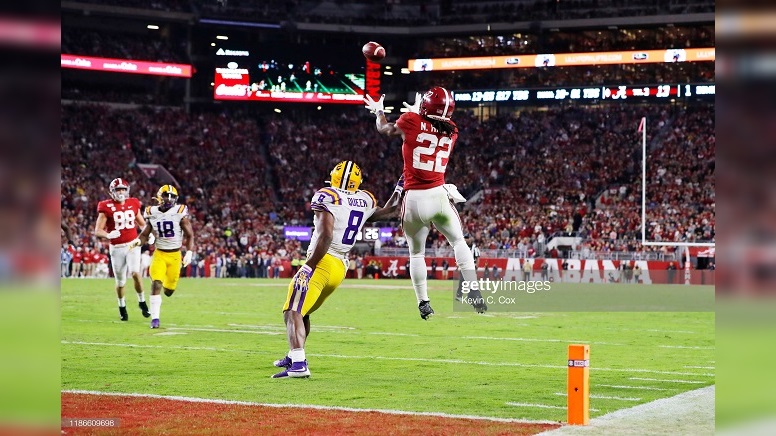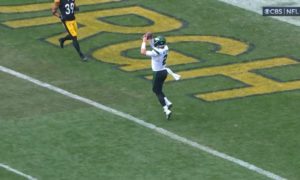With the 24th pick in the 2021 NFL Draft, the Pittsburgh Steelers selected Najee Harris, the running back out of Alabama. Harris was nearly the consensus top RB prospect in this year’s draft class across the board, regarded as the big, powerful feature back the Steelers haven’t had since Le’Veon Bell decided to hold out before the 2018 season. While the statement of Harris being a bruising back up the middle as a rusher is true, his skill set far transcends that of a typical early-down bruiser. He has deceptive elusiveness for his size and great vision to make cuts that most backs of his size can’t. He also is an impressive receiver for the running back position, improving every season in Tuscaloosa as a pass catcher both out of the backfield and when split out as a traditional receiver.
Harris ranked fifth in the FBS at the running back position in terms of receiving yards in 2020, tallying 425 yards, coming out to a little over 32 receiving yards per game via Sport Reference. Below are Harris’s receiving stats for the 2020 season, as well as for his entire college career. Included are frequent player comparisons for Harris at the pro level and their last season of college production before transitioning to the pros, as well as their entire college career receiving production.
2020 Receiving Stats: 43 receptions for 425 yards (9.9 YPC) and four TDs
Total Receiving Stats: 80 receptions for 781 yards (9.8 YPC) and 11 TDs
Le’Veon Bell 2012 Receiving Stats: 32 receptions for 167 yards (5.2 YPC) and one TD
Le’Veon Bell Total Receiving Stats: 78 receptions for 531 yards (6.8 YPC) and one TD
Matt Forte 2007 Receiving Stats: 32 receptions for 282 yards (8.8 YPC)
Matt Forte Total Receiving Stats: 103 receptions for 985 yards (9.6 YPC) and five TDs
Joe Mixon 2016 Receiving Stats: 37 receptions for 538 yards (14.5 YPC) and five TDs
Joe Mixon Total Receiving Stats: 65 receptions for 894 yards (13.8 YPC) and nine TDs
Now to the actual film analysis on Harris and his pass catching ability. We’ll first start with Harris coming out of the backfield. Here on this play against the Florida Gators, we see Harris leak out of the backfield to the right of the formation, running the angle route against the linebacker to the middle of the field, getting good inside leverage and separation on his route as he makes the catch in-stride and takes off up the middle, spinning through multiple tackle attempts and stretching out to the reach the ball over the goal line for the score.
Below is the All-22 version of the play where we see Harris and how nuanced he really is as a receiver. You can see him sell the outside fake at the top of his route, jabbing the ground and giving a head fake to the right, freezing the defender and then quickly cutting back inside, getting nearly five yards of separation from the coverage for the easy pitch and catch. This route execution for a WR would be impressive. For Harris who is nearly 6’2, 230 lbs. at RB? It’s exceptional.
The Florida game is a great example of Harris’ receiving prowess on full display. Having a bias to the Gators due to my time with the team, it was bittersweet seeing Harris tear them up through the air for three receiving scores on the night. Here on this play, we see Harris leak out to the left, catching the short yardage target only a couple of yards from he LOS. However, this play highlights Harris’ ability to create after the catch.
The defender is right on top of Harris shortly after the catch is made, but Harris manages to decelerate, execute a reverse spin move in space, and then reaccelerate to the goal line, putting his shoulder down and powering through the diving tackle attempt for the score. This sequence showcases the ability for Harris to instantly react to what is happening in front of him, make a move in space, and still get to the end zone for the TD.
On this play against the Buckeyes, Harris comes out of the backfield to the left on the wheel route, running wide open on the play. However, #10 Mac Jones throws the ball a little short, requiring Harris to slow down and make the grab with one hand as he turns back to the ball on the back shoulder. He is able to make the catch on the run instead of coming to a complete stop, running up the sideline and then again showing his vision and ability to decelerate and cut back inside on #32 Tuf Borland, jumping into the end zone, taking on contact from the defender as he falls in for the score. This is another example of Harris being able to create after the catch and make the grab from a different platform, catching the ball that was thrown behind him rather than on target.
Harris was well-utilized on wheel concepts during his time with the Crimson Tide. One new Steeler knows this all too well, as linebacker #1 Buddy Johnson from Texas A&M was tasked with covering Harris on this play. Johnson was in good position on Harris, but Harris climbs the ladder and plucks the ball off the top of the rim, attacking it at its apex just like a WR would and coming down with the ball inside the five. Notice how Johnson had his hand right in Harris’ face, but Harris shows the concentration and hand strength to make the grab while in the air and come down with the football to complete the process of the catch.
There are several instances on Harris’ tape that you could plausibly believe that he is actually a WR by the way he runs his routes and plays the ball in the air. Another great example is this play against LSU in 2019 where he runs the wheel route to the left of the formation, getting one-on-one coverage vs. current Ravens’ LB Patrick Queen. When the ball starts to arrive, Harris shows great body control and comes back to the football on the back-shoulder throw, positioning himself to put Queen on his back, leap up in the air, and turn in the air upon the catch to come down into the end zone for the TD. A phenomenal play for a RB out of the backfield.
While Harris has shown great ability to catch the ball out of the backfield, he is more than capable to line up out wide or in the slot to exploit matchups against linebackers. Here we see Harris line up at the top of the screen and show good get-off on the snap, coming back and sitting down for the curl route concept five yards from the LOS. However, Harris recognizes the LB in zone coverage coming to pick him up and runs the choice route back to the middle of the field, taking advantage of the LB having his back to him and the defensive back going back to play deep third in coverage, and catching the ball coming back inside. Harris then stiff arms #3 Marco Wilson and keeps the defender off of his frame like an adult stiff arming an angry little child for the score.
If you want to question whether Harris can make tough grabs going across the middle, this next play is for you. Harris showcases his physicality as a runner constantly, breaking out of arm tackles with regularity and requiring more than one defender to bring him down on most occasions. This physical demeanor is also displayed after the catch, having the contact balance to absorb the hit and stay upright whilst focusing on making the catch. Harris catches the ball here coming inside against Ohio State on the designed screen.
#41 Josh Proctor gets through the block and launches his left shoulder into Harris as he makes the catch. However, Harris is able to complete the catch, stay upright, and actually stabilizes enough to send Proctor flying to the side after he went for the light-up shot. Harris doesn’t score on the play, but he shows his toughness over the middle and willingness to sustain contact from the defender and hold onto the football while taking a big hit.
Now the real question: how will these skills demonstrated on tape translate to the NFL? When evaluating the potential impact Najee Harris can have on the passing game, we can look at some of his pro comparisons and how they are deployed in the passing game. First, let’s check out a couple clips of Le’Veon Bell. On this play, we see Bell aligned as a WR on the outside, showing great ability to cut inside on the slant route and make the easy grab for the score. While Harris was aligned in the backfield, his angle route from the Florida clip is nearly identical to Bell’s rep here getting separation inside.
Bell also has showcased his ability on the wheel route. On this play, Bell lines up in the slot on the right side, runs up the sideline against man coverage, and makes the acrobatic grab with one hand. While Harris’ one-hand grab against Ohio State wasn’t the same caliber, his ability to climb the ladder and make the combative catch against Texas A&M and LSU is fairly reminiscent to what we see here on this play.
I personally compared Harris to Matt Forte, who also was a bigger back that was an established receiver. Another comparison I have seen that I can get behind is Joe Mixon of the Bengals. Both players are over 6’1″ and around 230 lbs., boast tall, angular builds, are effective runners on the ground, and have ample pass catching production. However, when analyzing the college production above, Mixon outpaces both Harris and Bell in the receiving category, despite playing two less seasons. This is due to Mixon’s explosiveness and burst as a runner after the catch. We can see that here on these two clips from his college days at Oklahoma, where you see more angle-busting speed than Harris or Bell has.
However, there are examples in Mixon’s film that are similar to both Bell and Harris. Here we see Mixon make the contested catch against man coverage down the field that is eerily similar to several examples above.
Overall, if I had to compare Najee Harris as a receiver to the guys listed, I would say he slates between Bell and Mixon as an athlete. While Bell definitely slimmed down during his time in Pittsburgh compared to his rookie season, he was never really explosive and developed more as a route runner. Harris as a receiver is arguably a better athlete coming into the league than Bell was, and probably more refined as a receiver. However, Joe Mixon is definitely more dynamic than Harris was, having more juice in the open field and having the ability to pull away from defenses. I would argue that Harris’ skill set as a receiver is more nuanced that Mixon’s was coming out, though, given the way he was used in Alabama’s system and all the types or routes and catches he was asked to make.
People often praised Le’Veon Bell for his contribution as an RB #1 and a WR #2 for an offense. In my honest opinion, Najee Harris should be put in the same category, having the skill set to catch 50+ balls relatively easy in a 17-game season. RBs often get hate for being first-round selections, but I would argue the selection is justified with Harris, who if used properly in OC Matt Canada’s system where he likes to move his backs all over the place, can legitimately catch 50-60 passes and top 1,500 all-purpose yards with 1,700 not being out of the question. I expect Harris’ receiving skill set to continue to improve just as Bell’s did, making him a matchup nightmare as both a runner and a receiver out of the backfield and out wide for the black and gold.
Games Watched: vs. Florida (2020), vs. Texas A&M (2020), vs. Ohio State (2020), vs. LSU (2019)








